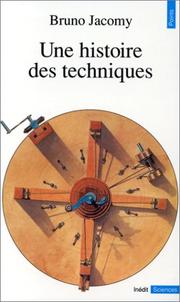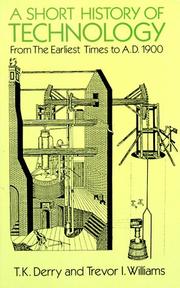| Listing 1 - 10 of 95 | << page >> |
Sort by
|

ISBN: 202012405X 9782020124058 Year: 1990 Volume: S67 Publisher: Paris: Seuil,
Abstract | Keywords | Export | Availability | Bookmark
 Loading...
Loading...Choose an application
- Reference Manager
- EndNote
- RefWorks (Direct export to RefWorks)
Ce livre répond à une exigence pressante. L'évolution de nos sociétés désormais est largement conditionnée par la technique. Comment assurer la maîtrise de ce développement sans en connaître l'histoire? Pour mettre à la portée de tous l'histoire des techniques, discipline récente et active, le présent ouvrage adopte une structure originale. Renonçant à une impossible exhaustivité, il propose, pour chacune des six grandes périodes d'un découpage temporel, d'abord une vision synthétique, puis un développement concret par la présentation d'un objet et d'un homme emblématiques de leur temps.
Technology --- Technologie --- History --- Histoire --- history --- History. --- Technology - history --- Technique
Book
ISBN: 1137598298 113759831X Year: 2019 Publisher: London Springer Nature
Abstract | Keywords | Export | Availability | Bookmark
 Loading...
Loading...Choose an application
- Reference Manager
- EndNote
- RefWorks (Direct export to RefWorks)
It is common for us today to associate the practice of science primarily with the act of seeing—with staring at computer screens, analyzing graphs, and presenting images. We may notice that physicians use stethoscopes to listen for disease, that biologists tune into sound recordings to understand birds, or that engineers have created Geiger tellers warning us for radiation through sound. But in the sciences overall, we think, seeing is believing. This open access book explains why, indeed, listening for knowledge plays an ambiguous, if fascinating, role in the sciences. For what purposes have scientists, engineers and physicians listened to the objects of their interest? How did they listen exactly? And why has listening often been contested as a legitimate form of access to scientific knowledge? This concise monograph combines historical and ethnographic evidence about the practices of listening on shop floors, in laboratories, field stations, hospitals, and conference halls, between the 1920s and today. It shows how scientists have used sonic skills—skills required for making, recording, storing, retrieving, and listening to sound—in ensembles: sets of instruments and techniques for particular situations of knowledge making. Yet rather than pleading for the emancipation of hearing at the expense of seeing, this essay investigates when, how, and under which conditions the ear has contributed to science dynamics, either in tandem with or without the eye. Karin Bijsterveld is historian and professor of Science, Technology and Modern Culture at Maastricht University, The Netherlands.
Acoustics in engineering. --- Technology-History. --- Engineering Acoustics. --- History of Technology. --- Technology --- History. --- Acoustical engineering. --- Technology—History. --- Acoustic engineering --- Sonic engineering --- Sonics --- Sound engineering --- Sound-waves --- Engineering --- Industrial applications --- Acoustical engineering --- Technology—History
Book
ISBN: 3030291197 3030291189 Year: 2019 Publisher: Cham : Springer International Publishing : Imprint: Springer,
Abstract | Keywords | Export | Availability | Bookmark
 Loading...
Loading...Choose an application
- Reference Manager
- EndNote
- RefWorks (Direct export to RefWorks)
This book follows the development of research on the origin of the Moon from the late 18th century to the present. By gathering together the major texts, papers, and events of the time, it provides a thorough chronicle of the paradigmatic shift in planetary science that arose from the notion that the Earth-Moon system was formed from two colliding planetary bodies. The book covers pre-Apollo ideas, the conceptual evolution during and subsequent to the Apollo explorations of the Moon, and the development of the Earth-Moon system consensus. A plethora of excerpts from key publications are included to demonstrate the shift in scientific focus over the centuries. Through its comprehensive review of lunar science research and literature, this book shows how new technologies and discoveries catalyzed the community and revolutionized our understanding of the Moon’s formation.
History. --- Planetary science. --- Planetology. --- Technology-History. --- History of Science. --- Planetary Sciences. --- History of Technology. --- Planetary sciences --- Planetology --- Annals --- Auxiliary sciences of history --- Moon --- Origin. --- Technology—History.

ISBN: 0486274721 9780486274720 Year: 1993 Publisher: New York: Dover,
Abstract | Keywords | Export | Availability | Bookmark
 Loading...
Loading...Choose an application
- Reference Manager
- EndNote
- RefWorks (Direct export to RefWorks)
Highly readable, profusely illustrated survey relates technology to historical epochs from earliest times to the onset of the Industrial Revolution, ca. 1750 a.d. and from the mid-18th century to the beginning of the 20th. Food production, metalworking, building construction, early sources of power, development of steam engine, mining, internal combustion machines, electricity and much more. Over 350 illustrations. Bibliography. Indexes. 354 black-and-white illustrations. 1961 edition.
Technology --- Technologie --- History --- Histoire --- history --- History. --- Technology - history --- #X-L: Casterman
Book
ISBN: 3319977075 3319977067 Year: 2018 Publisher: Cham : Springer International Publishing : Imprint: Springer,
Abstract | Keywords | Export | Availability | Bookmark
 Loading...
Loading...Choose an application
- Reference Manager
- EndNote
- RefWorks (Direct export to RefWorks)
The invention of the telescope at the dawning of the 17th century has revolutionized humanity's understanding of the Universe and our place within it. This book traces the development of the telescope over four centuries, as well as the many personalities who used it to uncover brand-new revelations about the Sun, Moon, planets, stars and distant galaxies. Starting with early observers such as Thomas Harriot, Galileo, Johannes Hevelius, Giovanni Domenico Cassini, Robert Hooke and Christian Huygens, the book explores how these early observers arrived at essentially correct ideas concerning the objects they studied. Moving into the 18th and 19th centuries, the author describes the increasing sophistication of telescopes both large and small, and the celebrated figures who used them so productively, including the Herschels, Charles Messier, William Lassell and the Earls of Rosse. Many great discoveries were also made with smaller instruments when placed in the capable hands of the Struve dynasty, F.W. Bessel, Angelo Secchi and S.W Burnham, to name but a few. Nor were all great observers of professional ilk. The book explores the contributions made by the 'clerical astronomers,' William Rutter Dawes, Thomas William Webb, T.E.R Philips and T.H.E.C Espin, as well as the lonely vigils of E.E. Barnard, William F. Denning and Charles Grover. And in the 20th century, the work of Percival Lowell, Leslie Peltier, Eugene M. Antoniadi, Clyde Tombaugh, Walter Scott Houston, David H. Levy and Sir Patrick Moore is fully explored. Generously illustrated throughout, this treasure trove of astronomical history shows how each observer's work led to seminal developments in science, and providing key insights into how we go about exploring the heavens today.
Astronomy --- History. --- Technology-History. --- Astronomy, Observations and Techniques. --- History of Science. --- History of Technology. --- Annals --- Auxiliary sciences of history --- Observations, Astronomical. --- Astronomy—Observations. --- Technology—History. --- Astronomical observations --- Observations, Astronomical
Book
ISBN: 3030044653 3030044645 Year: 2019 Publisher: Cham : Springer International Publishing : Imprint: Springer,
Abstract | Keywords | Export | Availability | Bookmark
 Loading...
Loading...Choose an application
- Reference Manager
- EndNote
- RefWorks (Direct export to RefWorks)
This book sheds light on environmental control in buildings from the 17th century onwards. Even before building services became a hallmark of buildings, in order to address increasing sanitary and comfort needs, pioneering experiences had contributed to improve design skills of professionals. After long being determined by passive features, indoor climate became influenced by installations and plants, representing the most significant shift of paradigm in the modern age’s construction history. This change was not without consequences, and the book presents contributions showing the deep connection between architectural design, comfort requirements and environmental awareness throughout the 19th century. Taking into account the differences between different European countries, the book is a valuable resource for architects, designers and heritage professionals who are interested in environmental design, enabling them to develop a deeper knowledge of heritage in order to address to climate demands, particularly going towards a future in which energy savings and fuel consumption reduction will dictate our behaviour. It includes contributions by leading international experts: Melanie Bauernfeind, Marco Cofani, Lino Vittorio Bozzetto, Emmanuelle Gallo, Alberto Grimoldi, Dean Hawkes, Angelo Giuseppe Landi, Mattias Legnér, Oriel Prizeman, and Henrik Schoenefeldt.
Buildings --- Environmental engineering --- History. --- Edifices --- Halls --- Structures --- Architecture --- Technology-History. --- Building Physics, HVAC. --- History of Technology. --- Energy Efficiency. --- Building construction. --- Technology—History. --- Energy efficiency. --- Consumption of energy --- Energy efficiency --- Fuel consumption --- Fuel efficiency --- Power resources --- Energy conservation
Book
ISBN: 9782130736431 2130736432 Year: 2016 Publisher: Paris: PUF,
Abstract | Keywords | Export | Availability | Bookmark
 Loading...
Loading...Choose an application
- Reference Manager
- EndNote
- RefWorks (Direct export to RefWorks)
L'histoire des techniques entre 1500 et 1800 est présentée dans une première partie par grandes zones géographiques (Europe, Afrique, Moyen-Orient, Asie, Amériques, Océanie, etc.), puis dans une seconde partie de façon thématique, afin d'insister sur les principales orientations de la recherche actuelle. Sont ainsi détaillés les liens entre les techniques et le pouvoir politique, l'agriculture, la religion, le genre, le corps, l'environnement, etc.L'objectif est de fournir un état de l'art tout en précisant les directions empruntées par la recherche en histoire moderne des techniques dans une perspective ouverte à l'échelle du monde, résolument comparatiste et soucieuse de regards croisés.
Technology --- history --- Social aspects --- Technologie --- History. --- Social aspects. --- Histoire --- Aspect social --- Technique --- Technology - history --- Technology - Social aspects
Book
ISBN: 383946112X Year: 2022 Publisher: Bielefeld transcript Verlag
Abstract | Keywords | Export | Availability | Bookmark
 Loading...
Loading...Choose an application
- Reference Manager
- EndNote
- RefWorks (Direct export to RefWorks)
The history of theatre has often been written as a history of great writers, actors, or directors. This book takes a different approach: The contributors examine the history of performance from the perspective of theatre spaces and stage technologies. Art, literature, religion, law, urbanism, architecture, technology - this interdisciplinary book discusses how these fields relate to theatre and performance. Geographically, it covers a significant portion of the globe; chronologically, it ranges from ancient times to the present. This book provides a timely attempt to combine cultural and global history.
Book
ISBN: 2222042356 9782222042358 Year: 1988 Volume: 25 Publisher: Paris: CNRS,
Abstract | Keywords | Export | Availability | Bookmark
 Loading...
Loading...Choose an application
- Reference Manager
- EndNote
- RefWorks (Direct export to RefWorks)
Industries, Primitive --- Prehistoric peoples --- Industries primitives --- Homme préhistorique --- Tools --- Outillage --- Technology --- History. --- History --- Homme préhistorique --- Tools. --- Technology - History. --- Industries, Prehistoric.
Book
ISBN: 8822254198 Year: 2005 Volume: 98 Publisher: Firenze : L. S. Olschki,
Abstract | Keywords | Export | Availability | Bookmark
 Loading...
Loading...Choose an application
- Reference Manager
- EndNote
- RefWorks (Direct export to RefWorks)
Machinery --- Technology --- Machines --- Technologie --- Philosophy --- Congresses --- Philosophie --- Congrès --- Mechanism (Philosophy) --- History --- 609 --- 472 --- Technology History --- Language Classical Latin Etymology --- Congrès
| Listing 1 - 10 of 95 | << page >> |
Sort by
|

 Search
Search Feedback
Feedback About UniCat
About UniCat  Help
Help News
News